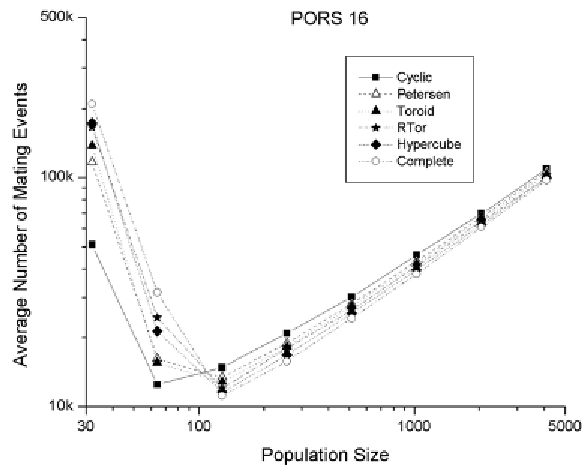Biomedical Engineering Reference
In-Depth Information
Figure 3. The average number of mating events to solution as a function of population size and graph
for the PORS 16 problem
the best known population size, average solution
time decreases as much as 94-fold for deceptive
problems, an additional performance increase of
nearly 50% of that obtained by selecting the right
type of graph.
Proper graph selection can also allow users
to obtain multiple distinct solutions. It has been
found in both test problems (Corns, Ashlock,
McCorkle, & Bryden, 2006a) and real world ap-
plications (Xiao, Bryden, Engelbrecht, Huang, &
McCorkle, 2004) that, while there is a graph that
will give a satisfactory solution in the shortest
amount of time, using a graph that has a higher
level of diversity preservation allows distinct
designs to remain in the population. This has
been established by making direct comparisons
between the population members at the conclusion
of experiments when different graph structures
were used to solve highly multi-modal problems.
Multiple distinct solutions are advantageous for
engineering design, where it is typically desirable
to have several design alternatives available.
TEST PRObLEMS
Initially 40 problems were used to evaluate the
impact that graph choice had on time to solution.
For 39 of these test problems, 5,000 simulations
were performed for each of the graphs listed in
Table 1. To obtain better resolution on the relative
ranking of the graph Graphs used in this study
with their index name for use in figures. The
graphs listed here are all population size 512.
performances, 10,000 simulations were performed
for the differential equation problem. For each
simulation, the number of mating events required
to find an acceptable solution were recorded.
These results were then used to find the mean and
95% confidence interval to allow comparison of
different graph performances. The problems fell
into four categories: string problems, real variable
problems, genetic programming problems (Koza,
1992; Banzhaf, Nordin, Keller, & Francone, 1998),
and a miscellaneous category.

Search WWH ::

Custom Search